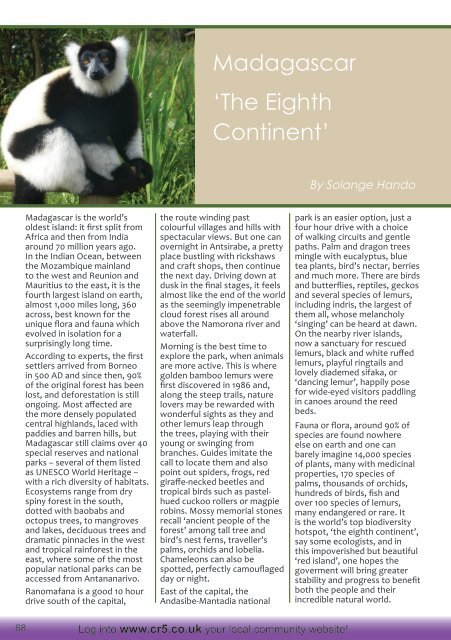You also want an ePaper? Increase the reach of your titles
YUMPU automatically turns print PDFs into web optimized ePapers that Google loves.
Madagascar<br />
‘The Eighth<br />
Continent’<br />
By Solange Hando<br />
Madagascar is the world’s<br />
oldest island: it first split from<br />
Africa and then from India<br />
around 70 million years ago.<br />
In the Indian Ocean, between<br />
the Mozambique mainland<br />
to the west and Reunion and<br />
Mauritius to the east, it is the<br />
fourth largest island on earth,<br />
almost 1,000 miles long, 360<br />
across, best known for the<br />
unique flora and fauna which<br />
evolved in isolation for a<br />
surprisingly long time.<br />
According to experts, the first<br />
settlers arrived from Borneo<br />
in 500 AD and since then, 90%<br />
of the original forest has been<br />
lost, and deforestation is still<br />
ongoing. Most affected are<br />
the more densely populated<br />
central highlands, laced with<br />
paddies and barren hills, but<br />
Madagascar still claims over 40<br />
special reserves and national<br />
parks – several of them listed<br />
as UNESCO World Heritage –<br />
with a rich diversity of habitats.<br />
Ecosystems range from dry<br />
spiny forest in the south,<br />
dotted with baobabs and<br />
octopus trees, to mangroves<br />
and lakes, deciduous trees and<br />
dramatic pinnacles in the west<br />
and tropical rainforest in the<br />
east, where some of the most<br />
popular national parks can be<br />
accessed from Antananarivo.<br />
Ranomafana is a good 10 hour<br />
drive south of the capital,<br />
the route winding past<br />
colourful villages and hills with<br />
spectacular views. But one can<br />
overnight in Antsirabe, a pretty<br />
place bustling with rickshaws<br />
and craft shops, then continue<br />
the next day. Driving down at<br />
dusk in the final stages, it feels<br />
almost like the end of the world<br />
as the seemingly impenetrable<br />
cloud forest rises all around<br />
above the Namorona river and<br />
waterfall.<br />
Morning is the best time to<br />
explore the park, when animals<br />
are more active. This is where<br />
golden bamboo lemurs were<br />
first discovered in 1986 and,<br />
along the steep trails, nature<br />
lovers may be rewarded with<br />
wonderful sights as they and<br />
other lemurs leap through<br />
the trees, playing with their<br />
young or swinging from<br />
branches. Guides imitate the<br />
call to locate them and also<br />
point out spiders, frogs, red<br />
giraffe-necked beetles and<br />
tropical birds such as pastelhued<br />
cuckoo rollers or magpie<br />
robins. Mossy memorial stones<br />
recall ‘ancient people of the<br />
forest’ among tall tree and<br />
bird’s nest ferns, traveller’s<br />
palms, orchids and lobelia.<br />
Chameleons can also be<br />
spotted, perfectly camouflaged<br />
day or night.<br />
East of the capital, the<br />
Andasibe-Mantadia national<br />
park is an easier option, just a<br />
four hour drive with a choice<br />
of walking circuits and gentle<br />
paths. Palm and dragon trees<br />
mingle with eucalyptus, blue<br />
tea plants, bird’s nectar, berries<br />
and much more. There are birds<br />
and butterflies, reptiles, geckos<br />
and several species of lemurs,<br />
including indris, the largest of<br />
them all, whose melancholy<br />
‘singing’ can be heard at dawn.<br />
On the nearby river islands,<br />
now a sanctuary for rescued<br />
lemurs, black and white ruffed<br />
lemurs, playful ringtails and<br />
lovely diademed sifaka, or<br />
‘dancing lemur’, happily pose<br />
for wide-eyed visitors paddling<br />
in canoes around the reed<br />
beds.<br />
Fauna or flora, around 90% of<br />
species are found nowhere<br />
else on earth and one can<br />
barely imagine 14,000 species<br />
of plants, many with medicinal<br />
properties, 170 species of<br />
palms, thousands of orchids,<br />
hundreds of birds, fish and<br />
over 100 species of lemurs,<br />
many endangered or rare. It<br />
is the world’s top biodiversity<br />
hotspot, ‘the eighth continent’,<br />
say some ecologists, and in<br />
this impoverished but beautiful<br />
‘red island’, one hopes the<br />
goverment will bring greater<br />
stability and progress to benefit<br />
both the people and their<br />
incredible natural world.<br />
68 Log into www.cr5.co.uk your local community website!

















